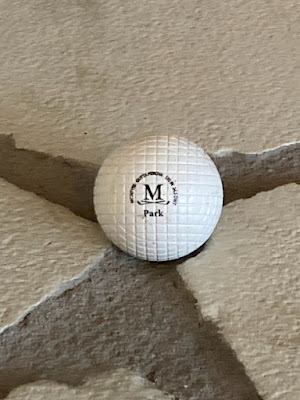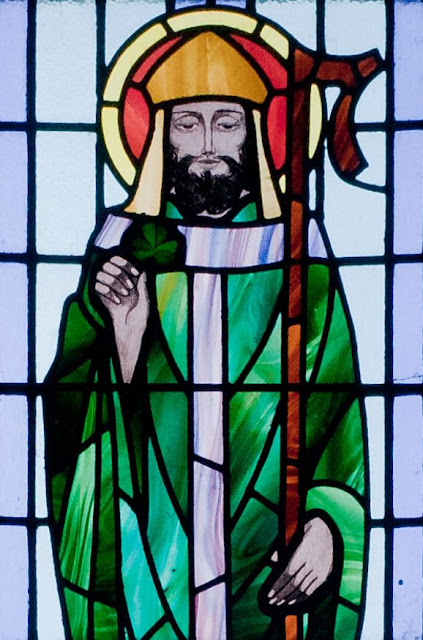Because of what He did on Calvary's cross -
“But he was wounded for our transgressions, he was bruised for our iniquities: the chastisement of our peace was upon him; and with his stripes we are healed.”
- Isaiah 53:5
- we can have peace with God through faith in His Son.
I hope you have experienced that reconciliation in your life, and wish you and yours a very blessed Easter.
Know what those are?
They're called "featheries" and they're the type of golf ball used prior to 1850.
They're made of leather and stuffed with - you guessed it - feathers. Lots and lots of them.
Then they're sewn shut and "finished" yielding a playable golf ball that's about 1.8" in diameter and between 1.2 to 1.4 ounces.
By way of comparison a modern ball is 1.68" in diameter and 1.62 ounces - and a McIntyre gutty is about 1.7" and 1.34 ounces.
So featheries are a little bigger and a little lighter than modern balls, but about the same weight as a gutty.
They're also mostly, but not necessarily perfectly, round.
How do I know all this?
I talked to the good folks at <hickory lane featherie> -
 |
| Denny and Cathy in 1840's garb at their featherie golf outing |
They should be, because they make each of their featherie golf balls by hand, just like the old masters from 200 years ago.
As I said, they're playable balls; in fact, they're one of only two brands that are approved for play in the National Hickory Championships (pre-1850 "featherie" era).
So...what does any of this have to do with my 1920's era hickory golf hobby?
Funny you should ask, since that's the subject of this week's blog entry.
And it's a bit of a tangle, so first, a golf history lesson:
From the 1700's through 1850 or so, the featherie ball ruled supreme, and clubs were predominantly long nosed woods with names like "play club", "long spoon" and "short spoon":
...its main advantage being that of its hard shell durability and some increased distance.
Clubs retained their basic long nose spoon shape, but became sturdier and heavier.
Also, irons like the "smooth face lofter" (about a 7 iron) and "rut irons" or "track irons" (used to get balls out of wagon tracks that often criscrossed public land golf courses)...
...started popping up.
By 1900 the gutty was being pushed off the stage by wound core balls due to vastly improved distance, and club makers once again adapted.
The long nose spoon shapes morphed into the driver / brassie woods that you see in my bag (above) and irons became much more common.
Finally, due to the advent of metal shaft clubs, the hickory era ended around 1935.
And that, of course, was the end of golf as we know it.*
So...why does any of this matter?
Because my hickory playset is comprised of 1920's era clubs, but I hit gutta percha golf balls from the 1850-1900 era!
Ok, this may not be as big a crisis as say, running out of your favorite sedative just before The View comes on, but it has stuck in my craw for a while now.
And as it happens, when I was procuring a driver from a fellow hickory golf enthusiast, he mentioned he'd participated in a <featherie golf event> last year...
 |
| video taken by <The Hickory Hacker> |
...raving about how relaxed it was and how much fun everyone had.
Thus began my journey that so far involves purchasing a couple of Hickory Lane featheries...
...and committing to building an historically accurate gutty era playset (which has the benefit of working for featheries as well).
My new playset - which, Lord willing, should be complete by July or August - will consist of a long spoon (from the tees), short spoon (from the fairway), and smooth face lofter (around the greens), all supplied by <Kelly Leonard>, a clubmaker extraordinaire from Canada.
He specializes in gorgeous 19th century clubs from the featherie and gutty eras; I purchased this putter from him back in 2017...
...when I was just getting started with hickory golf.
Kelly even supplied the period correct clubs for the award winning movie Tommy's Honour:
What all this means is I will soon be able to play historically accurate golf from the 3 best eras of golf:
Featherie, 1700-1850, using Hickory Lane featheries
Gutta Percha, 1850-1900, using McIntyre Park guttys
Vintage Hickory, 1900-1935, using a modern, low compression ball (like Callaway Super Softs)
It's uncertain if this personal realignment of my hickory golf equipment will yield a significant improvement in cosmic harmony and therefore usher in an unprecedented age of world peace and universal prosperity.
If it does not, at least I'll feel better about assuaging my CDO:
As I said to begin this segment, I should not be allowed to talk to people unsupervised because I end up doing stuff.
*opinions expressed in this blog do not always reflect reality
rotten /rŏt′n/
adjective
- Being in a state of putrefaction or decay; decomposed.
- Having a foul odor resulting from or suggestive of decay; putrid.
- Made weak or unsound by rot.
Sounds unpleasant, so better get a move on...
 |
| a friend from work attended the Monster Jam recently... |
 |
| ...he's the one with the ball cap on |
 |
| taken with my reto 35mm from our backyard...can't wait for some leaves on those skeleton trees |
 |
| more from the backyard golf course |
That, dear reader, brings us to the end of another excitin' foray into the world of blogging excellence:
So take that.
later, mcm fans...































































